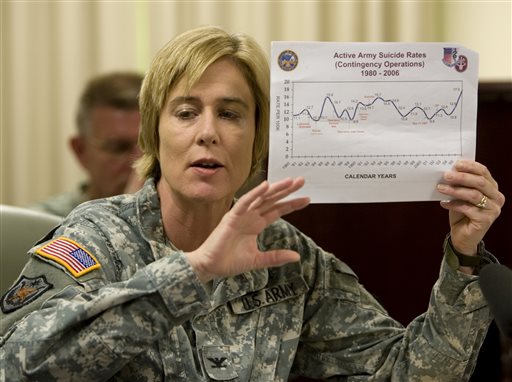WASHINGTON - Suicides among Army National Guard and Reserve members increased last year, even as the number of active-duty troops across the military who took their own lives dropped by more than 15 percent, according to new data.
The overall totals provided by the Army, Navy, Air Force and Marine Corps give some hope that prevention programs and increased efforts to identify troops at risk may be taking hold after several years of escalating suicide rates. But the increase among Army National Guard and Reserve members raises questions about whether those programs are getting to the citizen soldiers who may not have the same access to support networks and help that their active duty comrades receive.
Not only did suicides among Army National Guard and Reserve members increase from 140 in 2012 to 152 last year, but the 2013 total exceeded the number of active-duty soldiers who took their own lives, according to the Army. There were 151 active duty soldier suicides last year, compared with 185 in 2012, Army officials said.
The Pentagon released a report Friday that provided final data for 2012 suicides and some preliminary numbers for 2013. But the department data differs a bit from the totals provided by the services because of complicated accounting changes in how the department counts suicides by reservists. Some of the Pentagon numbers were finalized a year ago, while the services have more recently updated totals that reflect the results of some death investigations.
According to the four military services, there were 289 suicides among active duty troops in 2013, down from 343 in 2012. The vast majority were in the Army, the nation's largest military service. The Navy saw a 25 percent decline, from 59 in 2012 to 44 in 2013. The Marines went from 48 to 45, while the Air Force went from 51 to 49.
Due to the accounting changes and other updates, the Pentagon numbers are generally a bit lower and reflect a larger decline in overall active-duty suicides of about 18 percent from 2012 to 2013. In some cases, the services are counting Guard and Reserve members who have been called to active duty as part of the active duty total, while the Pentagon did not.
Both sets of numbers, however, show the same trends: fewer active duty suicides across all four services and slightly more deaths among the Army National Guard and Reserve.
The Pentagon also released detailed demographic data on the 2012 suicides, showing that more often they involve young, white men using a non-military issued gun. They also frequently had reported family or relationship stress.
Military leaders say it's too soon to declare success in the battle against suicides, but they say that some programs appear to be working.
"I think we've changed the cultural mindset - that it's OK for a sailor or a soldier or an airman or Marine to come forward and ask for help," said Rear Adm. Sean Buck, the Navy's officer in charge of suicide prevention and resilience programs. "We're trying to reduce the stigma that used to exist."
Buck said the Navy has focused on doing more programs designed to reduce stress, including teaching sailors coping mechanisms and stress management tools.
For example, he said, Navy leaders noticed a spike in suicides by medical specialists, including doctors and nurses, reaching a total of 22 for 2011 and 2012 combined. The Navy surgeon general started a program that found that there seemed to be a lot of transitions during that time involving the sailors' jobs or base locations.
Buck said that due to the frequent moves, sailors could sometimes find themselves unconnected to their families or units or higher command. "In many instances, if you find yourself in time of need and you're not in a permanent command, you may not know who to turn to," he said.
In response, Navy leaders were told to reach out to communicate with their medical specialists on a daily basis, checking with them to see how they were doing and if there were any problems.
Last year, Buck said, there was a sharp decline in suicides among the medical community, with six in 2013.
Lack of consistent contact with leaders or units could also be a factor for reservists.
Scattered across the United States, often in small or remote rural communities, many members of the Army National Guard and Reserve report for training about one weekend a month and two weeks in the summer. And they often don't have quick access to military medical or mental health services that may be on bases far from their homes. That means the outreach effort by the armed services to address the increase in suicides may not always get to reservists in need - particularly those who don't actively seek help.
According to the Army data, more than half of the reservists who committed suicide in 2012 and 2013 had served in Iraq and Afghanistan. Officials, however, have not been able to establish a strong link between military service on the warfront and suicide.
Army spokeswoman Lt. Col. Sunset Belinsky said the Army set up several programs to deal with the problem, including a 24-hour suicide prevention phone line. The Army Reserve set up six Army Strong Community Centers in New York, North Carolina, Pennsylvania, Oregon, Connecticut and Michigan.

